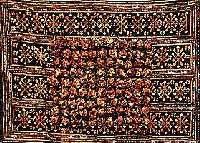Looking after cross-stitched works

Embroidered items, such as tablemats and napkins, which are intended to be used rather than displayed, must be laundered at regular intervals to remain in tiptop condition. If you suspect that the threads may not be colorfast, have the piece dry-cleaned instead of cleaning it yourself. The best way to clean cross-stitched works is to wash them carefully by hand in hot water with a mild, detergent-free cleaning agent. Most specialist fabric shampoos are ideal, but check that they do not contain optical brighteners, which will cause the thread and fabric colors to fade. Rinse thoroughly several times and then roll in a towel and press gently to remove surplus water. Gently ease back into shape and dry away from direct sunlight.
When using table linen, take immediate measures to correct spills and stains: Mop up the excess liquid with paper towels or tissues and rinse the fabric under running tepid water. Scrape off spilled foods quickly and then blot with a paper towel before washing in the usual way. For stubborn stains, use a solvent or brand-name stain remover, but be sure to test a small area first; if unsure, seek professional advice. When treating stains, remember that it is better to repeat a mild treatment several times rather than using a harsh solvent that may damage both threads and fabrics.

Press the embroidery while it is still slightly damp: Pad an ironing board with a couple of old, clean towels, then lay the embroidery on with the wrong side up. Cover with a piece of clean white fabric (a cotton sheet is ideal). Set your iron to a temperature that corresponds to the fabric's composition, for example, the linen setting for linens, slightly cooler for Aida and cotton fabrics, and even lower for even-woven fabrics made from cotton/viscose mixtures. Press lightly, taking care not to flatten the stitches. Old-fashioned laundry starch will give an attractive, crisp finish to table linen. Make sure the iron is not too hot.

Before storing the cross-stitched works, make sure they are clean and dry. Avoid storing fabrics for any length of time in polythene bags since the static electricity created by polythene attracts dirt and dust which will sully the fabric. Sealed polythene bags also prevent natural fibers, such as cotton and linen, from "breathing," which can result in mildew and eventually weaken or rot the fibers. Instead, store small items laid flat, and larger ones rolled around an acid-free cardboard tube protected by layers of white, acid-free tissue paper. For items too large to roll up, fold loosely between layers of white tissue paper, making sure that each fold is padded with tissue. Store all of the items in their own clean fabric bags in drawers, cupboards or other dark, dry and moth-free places. Small fabric bags of dried lavender add a sweet scent and help prevent moths.










